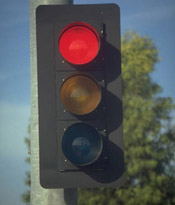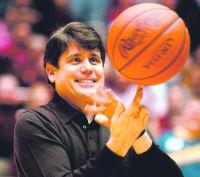 A couple of weeks ago, the City of Peoria released this information about the city’s traffic signals:
A couple of weeks ago, the City of Peoria released this information about the city’s traffic signals:
The American Public Works Association (APWA), as part of the National Transportation Operations Coalition (NTOC), participated in the release of the 2007 Traffic Signal Report Card during a press conference on October 9, 2007 in Washington D.C. Nationwide, the report graded traffic signals with a D, which was a slight improvement over the D- that was recorded in the 2005 report. The City of Peoria participated in the 2007 assessment and received a B on the report card. This is an improvement from 2005, when the City of Peoria scored a D+. The City scored very well on several areas in particular such as maintenance and signal operation at individual intersections. Much of this improved score can be attributed to the attention that has been given to the traffic signals. Improvements such as LED signals, battery backup and attention to signal coordination have improved and upgraded the condition of Peoria’s traffic signals. The effort and work that has been put into traffic signals has paid dividends with short travel times and improved safety for the traveling public. With the completion of the I74 project and the shifting of traffic volumes due to growth, continuous attention is required to maintain the current level of traffic signal operation.
It’s unclear whether this grade was based on an independent audit of Peoria’s traffic signals or a self-assessment completed by the city’s own Public Works department. Regardless, APWA gives Peoria a grade of “B,” and one of the reasons, according to the city, is because of improvement in “attention to signal coordination.”
Maybe other communities have worse signal coordination, but I know I often experience poor traffic light coordination in some corridors, including Sterling (esp. the I-74 interchange), University (between War Memorial and Main), and Knoxville (between I-74 and War Memorial — the light at McDonalds/Thrush is especially bad). So I was surprised to see Peoria scoring so high.
Of course, this report just reports on existing traffic signals and how well they’re operated, maintained, and managed. What it doesn’t look at is the overall context. Are there too many traffic signals? Is that the only tool in our public works toolbox for controlling traffic flow? Are there intersections that would be better served with roundabouts instead? Could certain intersections have been designed to mitigate the need for as much signal control as they have (e.g., the I-74 interchanges at Sterling and University)?
It might be worthwhile to consider an even broader context. Is the increase in traffic signals ultimately a city planning issue, not a public works issue? One could argue that by allowing suburban growth that segregates land uses (residential separated from commercial and retail uses), we’ve created an environment that is automobile-dependent, which has in turn led to increased traffic, necessitating wider roads with more capacity, and thus more traffic signals.
In light of that context, I wonder what grade Peoria’s traffic signals would receive.

 The Chicago Tribune ran a
The Chicago Tribune ran a